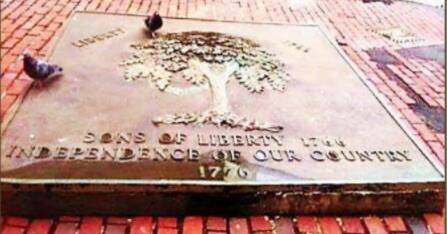The Boston Liberty Tree is believed to have been planted by Jared Bourne in his yard nine years after he was granted eight acres of land in Boston, Mass.
In 1630, the Massachusetts Bay Colony, the area surrounding Boston, and the islands in the Bay, contained thousands of acres of hardwood forests. Between Boston and Roxbury (four miles to the southwest) there was a large timbered area — the Boston Neck — that Colonists travelled to transport and exchange goods. Travelers were often ambushed as they journeye between the two towns; as a result the forest was cleared and the trees felled for building materials and firewood. The removal of the forests resulted in flooding the Neck with sea water. In 1646, Boston Colonists came together to replant trees throughout the area; the Liberty Tree was one of the trees planted on the Bourne property.
Although Bourne sold his house and land in 1665, the tree remained and continued to grow to an enormous size, becoming an icon of freedom and liberty and a gathering place for early American patriots during the lead up to the American Revolution.
The elm became known as the “Liberty Tree” because it was used as a gathering place from the start of resistance to British rule and the March 22, 1765 Stamp Act that imposed a heavy tax on every page of printed paper, newspapers, playing cards, and dice.
American Colonists came together in revolt to fight oppressive taxation by the British. Patriots, called the Sons of Liberty, gathered regularly beneath the Liberty Tree; the area surrounding the tree was referred to as “Liberty Hall.” Effigies of the Stamp Officer were hung from the tree.
A flagstaff was attached to the trunk of the tree that extended above the tree’s canopy where a flag would be raised to signal to the Sons of Liberty that it was time to assemble and take action.
The Liberty Tree became an embarrassment to the British and their allies who cut the Liberty Tree down in 1775 during The Siege of Boston. The ax-wielding party, led by Job Williams, made for an angry and aggressive scene as they took down the majestic tree, taunting and laughing at the Sons of Liberty, and taking away more than fourteen cords of firewood.
A British soldier was killed while trying to remove one of the limbs.
Soon after, a pole was erected from the tree’s stump and a plaque was placed directly over the spot where the tree once stood to commemorate Liberty. The plaque reads: “Sons of Liberty 1766 Independence of our Country 1776.” Marquis de Lafayette, major-general of the Continental Army under George Washington, said, “The world should never forget the spot where once stood “Liberty Tree,” so famous in your annals.”
The Michael Trebert Chapter of the Daughters of the American Revolution (DAR) is conducting the Forks American Elm Heritage Project in 2021-22. The project is part of the upcoming 250th Anniversary – in 2026 – of our nation’s founding. The project will culminate Arbor Day, April 29, 2022, with the commemorative planting of American elm saplings near Forks City Hall, and placement of an interpretive sign that describes the importance of reestablishing American elms in our nation.
Donations to support the Elm project may be made by sending a check – memo ELM — to the Michael Trebert Chapter / DAR, and mailed to P.O. Box 1917, Port Angeles, Wash. 98362.
Trebert/DAR is a 501 3(c) Non-profit Organization.
Michael Trebert Chapter – 7027WA-NSDAR
National Society Daughters of the American Revolution
P.O. Box 1917



